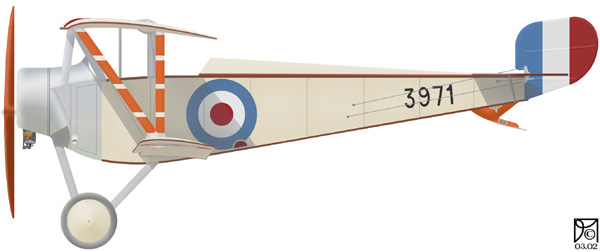Nieuport 10
The Nieuport 10 marked a significant break for Nieuport from the monoplanes
those exploits had made Nieuport famous. Originally designed as a racer
for the 1914 Coupe Gordon Bennett, it featured a variable incidence lower
wing to improve low speed handling without imposing a significant drag
penalty. It appeared too late to have been run in the race, and in any
case the race was cancelled because of the escalations prior to the outbreak
of the First World War. It took several months before it was presented
to military authorities in both France and Great Britain, but orders were
not immediately forthcoming partly due to the procurement system in place,
and partly due to the complexity of the design, which would be reduced
before being presented again, successfully.
Between the first prototype and production orders being received, Nieuport
was kept busy building the Voisin 3 under license, and the changes reflect
their experience with the Voisin. The design was simplified considerably,
so that the horizontal stabilizer for instance was changed from having
five bends to only two, and the wings were similarly modified. The incidence
mechanism was deleted as was the pedestal mount for a flexible machine
gun over the top wing. In this form it entered service with the French
Air Service in small numbers but was again modified to have a horseshoe
cowling, but still kept the pilot in the rear, with the observer in front
(where his absence or presence wouldn't affect the centre of gravity much).
In this form it entered the British Royal Naval Air Service (R.N.A.S.)
and was used in most of the theatres that the Royal Navy operated land
planes.
The pilots of the RNAS discovered that it made an effective single seater,
with a light machine gun mounted at and angle over the front seat. Shortly
afterwards purpose built single seaters appeared from the factory and
served in fairly large number with many nations, including the Belgians
who used them long after they were obsolete; the Russians, who were so
impressed they built thousands under licence; and in France itself, where
it was among the first to be used to counter the Fokker offensive.
Nieuport was quick to come out with the Nieuport 11, a purpose built
single seat fighter but the Nieuport 10 outlasted the Nieuport 11 in service
as it became a popular trainer in many countries, being produced until
well after the war was over as far away as Japan, where it was to serve
until the end of the 1920's. Later two seaters had the pilot and observer
swapped and some rudimentary predestal gun mounts were tried before the
10 was gradually replaced by the slightly larger 12. From 1917 onwards
a version was produced specificly for training, as the Nieuport 83E2 which
was used by France, the USAS, Japan and many smaller nations eager to
get into aviation after the war.

Belgium 188
Two seater in Belgian service, probably being used as a squadron hack.
Note the different shape of the forward coaming to the later aircraft,
which was originally intended to protect the observer while he stood up
through the top wing.

Belgium 102 (fighter)
Belgium received many types when they had been deemed obsolete in French
service, and the Nieuport 10 was among these.

France N237
Some of the earlier Nieuport 10's delivered to the French were in a
finish that appears dark on orthochromatic film. Since no documentation
seems to have survived this is a bit of a guess, one of the alternatives
being a strong yellow colour, which also appears dark. The serial presentation
is typical of 1915 machines.

France Guynemer
Between 1915 and 1916, many of the French aces were running their scores
up on the Niueport 10, including Guynemer who flew at least three before
moving on to the Nieuport 11.

Italian Macchi
The company known as Aermacchi was formed to build the Nieuport IV.G
under licence as the Nieuport-Macchi company, and they continued with
the Nieuport 10, which underwent a number of major improvements not seen
on other machines, including the Nieuport 17 like fairing on the fuselage
sides. They appear to have produced these up to the end of the war, and
were in service until late in the 1920's with flying schools that serviced
the military. This example carries one of several camouflage schemes used
after 1917.

RNAS Early
Very early RNAS Nieuport 10, with an unusual tail markings, shared
by most of the unit's aircraft. The French roundels were retained on the
wings as no official directive had been issued for marking RNAS aircraft
and it simplified deliveries.

RNAS 3165
Another fairly early RNAS machine, but with the serial marked clearly
on the rear fuselage.

RNAS 3971
The aircraft in which the first Canadian aerial victory was scored,
over a German seaplane. No photographs survive as the machine was lost
later the same day, but the other aircraft in the unit were all painted
the same, there only being slight variations in the position and size
of the roundel. French roundels were still retained on the wings, and
had this machine survived a few more months would have been repainted
as many of its contemporaries were.

Russian 621
One of an early batch of French built Nieuport 10's in Imperial Russian
Air Service, with the cocards typical of aircraft from France in the usual
six wing positions.

Russian Dux/100hp Gnome
Dux built Nieuport 10, with a number of modifications, including having
a 100hp Gnome monosoupape instead of the 80hp LeRhone typical to most
10, extra cooling holes in the cowling (which was black on some examples),
and a Vickers machine gun mounted on the top wing, with a streamlined
cover for the ammunition. The actual shape of the cover varied between
early and late examples, there being many field modifications before they
started comong from the Dux factory. The roundels are typical of Dux built
examples and were used in 14 positions.
| 







|

















